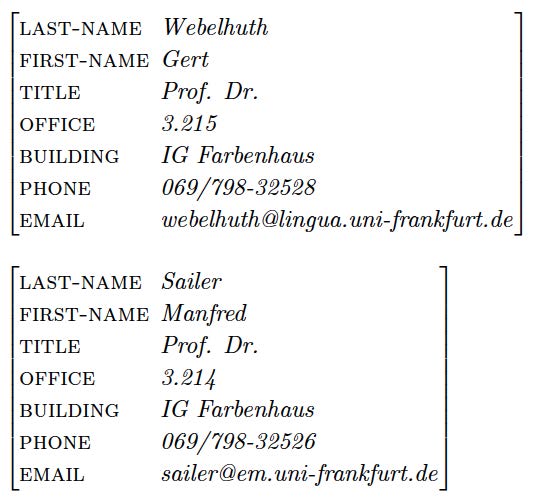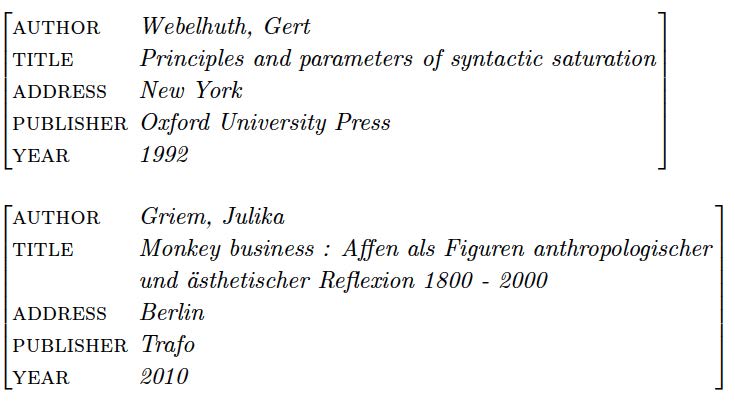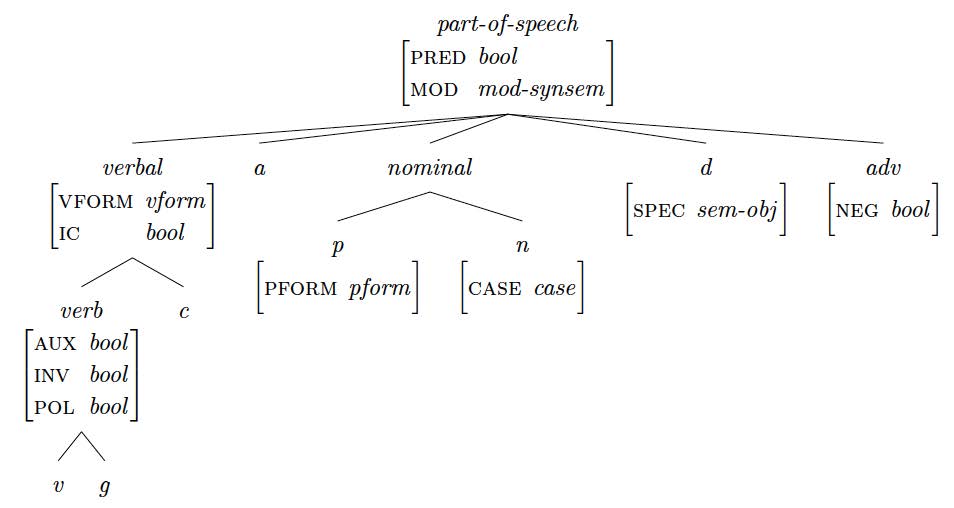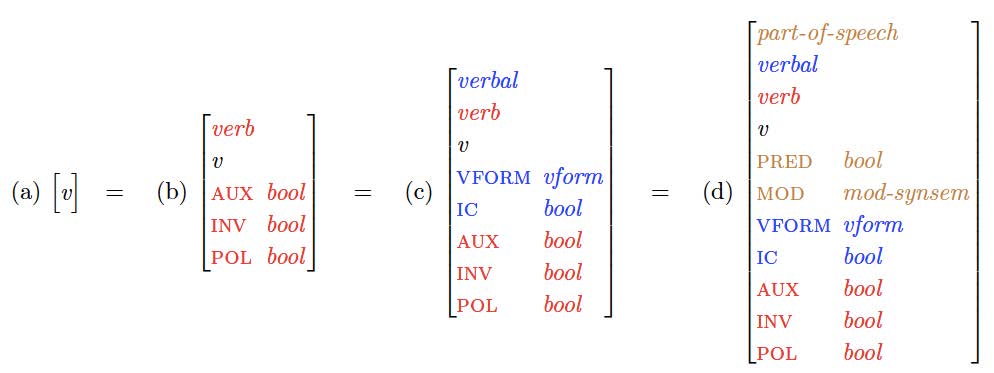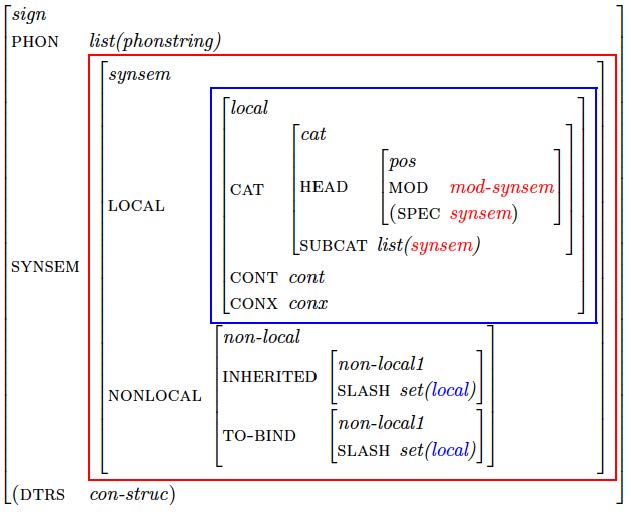User:Gert: Difference between revisions
No edit summary |
No edit summary |
||
| (90 intermediate revisions by the same user not shown) | |||
| Line 1: | Line 1: | ||
[[Syntax_1_Wiki|Syntax 1 Wiki]] | |||
[[Constraint-based_Syntax_2|Syntax 2]] | |||
[[Grammar-Writing|Grammar Writing]] | |||
[[GS-2000|Ginzburg and Sag (2000)]] | |||
[[HPSG|Head-Driven Phrase Structure Grammar]] | |||
[[Syntax_1_Wiki_Aenderungen|Syntax 1 Wiki: Änderungen]] | |||
<center> | |||
<embedvideo service="youtube" dimensions="400">https://www.youtube.com/watch?v=JRiX8Jiq_Z4</embedvideo> | |||
</center> | |||
[ Parts of the clause] | |||
<!-- This is a comment --> | |||
∀''x'' ('''cat'''(''x'') : ∃''y''('''likes(''y'', ''x'')) | |||
⊃ ∧ ¬ ∨ ≡ ∀ ∃ æ ⊕ Ø ⇒ <u>Unterstrichen</u> → ⇒ | |||
Text davor | |||
<blockquote>Blockquote</blockquote> | |||
Text danach | |||
<font face="Arial, Helvetica, sans-serif"> | <font face="Arial, Helvetica, sans-serif"> | ||
<font size="3"> | <font size="3"> | ||
< | Font size 3 | ||
</font> | |||
<span style="color: red>Text color</span> | |||
[<sub>NP</sub> labeled brackets ] | |||
Superscripts<sup>1</sup> | |||
Definitionsliste: | |||
;Begriff 1 | |||
: Beschreibung 1 | |||
;Begriff 2 | |||
: Beschreibung 2-1 | |||
: Beschreibung 2-2 | |||
Text einrücken: | |||
: Einfache Einrückung | |||
:: Doppelte Einrückung | |||
::::: Mehrfache Einrückung | |||
Nummered list: | |||
# Erstes Element der ersten Ebene | |||
## Erstes Element der zweiten Ebene | |||
## Zweites Element der zweiten Ebene | |||
# Zweites Element | |||
Bulleted lists: | |||
* Erstes Element der ersten Ebene | |||
** Erstes Element der zweiten Ebene | |||
** Zweites Element der zweiten Ebene | |||
* Zweites Element | |||
[[File:employees.jpg]] | |||
[[File:books.jpg]] | |||
[[File:iphones.png]] | |||
[[File:pos-jpg.jpg]] | |||
[[File:pos-v-1.jpg]] | |||
[[File:pos-v-2.jpg]] | |||
=== Establishing the head of a phrase === | |||
Establish what phrase the words below form and identify the head of the phrase! | |||
<quiz display=simple> | |||
{ ''Example:'' <span style="color: blue>surprised them.</span> | |||
| type="{}" } | |||
The words above form a { VP _5}. The head of this phrase is the { verb _12} { surprised _15}. | |||
</quiz> | |||
<quiz display=simple> | |||
{ ''Example:'' <span style="color: blue>with a friend.</span> | |||
| type="{}" } | |||
The words above form a { PP _5}. The head of this phrase is the { preposition _12} { with _15}. | |||
</quiz> | |||
=== Valence | === Valence === | ||
| Line 106: | Line 131: | ||
</font> | |||
| Line 175: | Line 200: | ||
| Line 191: | Line 216: | ||
</quiz> | </quiz> | ||
http://www.ello.uos.de/field.php/Syntax/Syntax | |||
[https://www.youtube.com/watch?v=XLvv_5meRNMp Parts of the clause] | |||
[https://www.youtube.com/watch?v=pF0RgB1dZTU A video on constituent tests] | |||
[https://www.youtube.com/watch?v=JRiX8Jiq_Z4 A video on the concept '''grammar'''] | |||
[https://www.youtube.com/watch?v=XLvv_5meRNM Sentence meaning] | |||
<iframe width="420" height="315" | |||
src="https://www.youtube.com/embed/JRiX8Jiq_Z4"> | |||
</iframe> | |||
Latest revision as of 08:16, 10 October 2017
Head-Driven Phrase Structure Grammar
[ Parts of the clause]
∀x (cat(x) : ∃y(likes(y, x)) ⊃ ∧ ¬ ∨ ≡ ∀ ∃ æ ⊕ Ø ⇒ Unterstrichen → ⇒
Text davor
Blockquote
Text danach
Font size 3
Text color
[NP labeled brackets ]
Superscripts1
Definitionsliste:
- Begriff 1
- Beschreibung 1
- Begriff 2
- Beschreibung 2-1
- Beschreibung 2-2
Text einrücken:
- Einfache Einrückung
- Doppelte Einrückung
- Mehrfache Einrückung
- Doppelte Einrückung
Nummered list:
- Erstes Element der ersten Ebene
- Erstes Element der zweiten Ebene
- Zweites Element der zweiten Ebene
- Zweites Element
Bulleted lists:
- Erstes Element der ersten Ebene
- Erstes Element der zweiten Ebene
- Zweites Element der zweiten Ebene
- Zweites Element
Establishing the head of a phrase
Establish what phrase the words below form and identify the head of the phrase!
Valence
2. Kim needs new shoes. 3. Kim talked to the student. 4. Kim sent the student to Robin. 5. Kim lent Robin a bicycle. 6. Kim told Robin that the student likes her. 7. Kim suggested to Robin that the student likes her. 8. Kim wants [to eat an apple.] 9. Kim believes Robin to like the student. 10. Kim seems to like the student. 11. Kim is intelligent. 12. Kim found the movie interesting. 13. Kim talked to Robin about the student. 14. Kim saw Robin talk to the student. 15. The student amuses Kim. 16. Kim came out of the room.
Words
| Verb | SUBJ | COMPS |
|---|---|---|
| snore | <NP> | <> |
| own | <NP> | <NP> |
| put | <NP> | <NP,NP> |
Verb SUBJ COMPS
snore <NP> <> own <NP> <NP> put <NP> <NP,PP>
When you look up the word scissors in the Oxford Learner's Dictionary, you are given the following information about it:
| Phonology | scissors |
| Part of speech | noun |
| Number | plural |
| Content | a tool for cutting paper ... |
The following representation shows how we will structure the information in a word in this course:
http://www.ello.uos.de/field.php/Syntax/Syntax
A video on the concept grammar
<iframe width="420" height="315"
src="https://www.youtube.com/embed/JRiX8Jiq_Z4">
</iframe>
